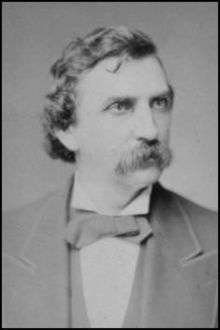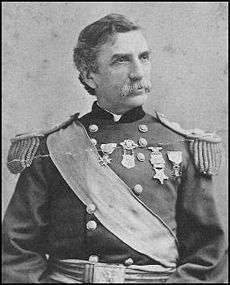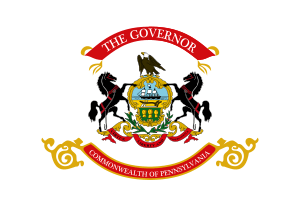John F. Hartranft
| John F. Hartranft | |
|---|---|
 | |
| 17th Governor of Pennsylvania | |
|
In office January 21, 1873 – January 21, 1879 | |
| Lieutenant | John Latta |
| Preceded by | John W. Geary |
| Succeeded by | Henry M. Hoyt |
| Personal details | |
| Born |
John Frederick Hartranft December 16, 1830 New Hanover Township, Montgomery County, Pennsylvania |
| Died |
October 17, 1889 (aged 58) Norristown, Pennsylvania |
| Resting place | Montgomery Cemetery (West Norriton Township, Pennsylvania) |
| Political party | Republican |
| Spouse(s) | Sallie Douglas Sebring |
| Profession | Lawyer |
| Awards | Medal of Honor |
| Military service | |
| Allegiance |
United States of America Union |
| Service/branch |
United States Army Union Army |
| Years of service | 1861–1865 |
| Rank |
|
| Battles/wars |
American Civil War *First Battle of Bull Run *Battle of Fort Stedman |
John Frederick Hartranft (December 16, 1830 – October 17, 1889) was a politician, the 17th Governor of Pennsylvania from 1873 to 1879. He had served during the American Civil War, reaching the rank of Union major general. He was later awarded the Medal of Honor for his actions in the First Battle of Bull Run in 1861, when he stayed past his term of enlistment in order to fight with the Union and rallied several regiments.[1]
Early life and career
Hartranft was born in Fagleysville, a village in New Hanover Township, Montgomery County, Pennsylvania, near Pottstown, the son of ethnic German Americans Mary Lydia (Bucher) and Samuel Engle Hartranft.[1] His paternal immigrant ancestor was Abraham Hartranft (1723 - 1776), born in Silesia and who settled in the Province of Pennsylvania during the colonial era.[2]
Hartranft had some local schooling in Norristown, where his family moved when he was a boy. He attended Marshall College in Mercersburg—a forerunner of Franklin & Marshall College in Lancaster. He moved to New York, where he completed his degree in civil engineering in 1853 from Union College in Schenectady.
He briefly worked for two railroads in eastern Pennsylvania before returning home to Norristown to assist his father in the real estate and stage line businesses. In 1854, the young man was appointed deputy sheriff of Montgomery County, Pennsylvania. That same year, he married Sallie Douglas Sebring. They had six children, but three died in infancy.
Hartranft was active in the Norristown fire company and the local Freemason lodge.[3] After "reading the law" as an apprentice with an established firm, Hartranft was admitted to the bar in 1860. He entered the Pennsylvania Militia, being promoted to the rank of colonel.
Civil War
In April 1861, Hartranft raised a Montgomery County regiment of 90-day volunteers in Norristown, serving as colonel of the 4th Pennsylvania Volunteer Infantry. When their term of enlistment was up, the regiment returned to Pennsylvania, although it was the eve of the First Battle of Bull Run, and firing had already begun. Hartranft was humiliated by his men's decision to go home.
He stayed to fight with the Army on July 21, 1861. This act earned him the Medal of Honor on August 21, 1886, for volunteering his services to fellow Pennsylvanian Col. William B. Franklin. His citation reads: "Voluntarily served as an aide and participated in the battle after expiration of his term of service, distinguishing himself in rallying several regiments which had been thrown into confusion."[1]
Hartranft raised a three-year regiment, the 51st Pennsylvania Infantry, and became its colonel. They first served on the North Carolina coast in the Burnside Expedition. Hartranft led them in battle at Roanoke Island and New Bern. In July 1862, Hartranft's men proceeded to Newport News, Virginia, to become part of Burnside's IX Corps, with whom they fought in the Second Battle of Bull Run and at South Mountain. They also fought at the Battle of Antietam, where Hartranft led the famous charge across Burnside's Bridge, suffering 120 casualties.[4] They also participated in the Battle of Fredericksburg. The 51st Pennsylvania was transferred to the Western Theater, where Hartranft saw action at the battles of Vicksburg, Campbell's Station, and Knoxville; in the latter two actions, he served as commander of the 2nd Division of the IX Corps while still a colonel.[5]
He commanded the 1st Brigade, 3rd Division, of the IX Corps in the 1864 Overland Campaign, participating in the fighting at the Wilderness and Spotsylvania. He was promoted to brigadier general as of May 12, 1864. He continued in operations against Richmond and Petersburg. His brigade distinguished itself in the Battle of Peebles' Farm.
When the IX Corps was reorganized, Hartranft was given command of a new 3rd Division, consisting of newly raised Pennsylvania regiments. Hartranft was brevetted major general by Lt. Gen. Ulysses S. Grant for defeating Confederate General Robert E. Lee's last offensive at the Battle of Fort Stedman. He brought his untested division from its reserve position and counterattacked to recover the captured fort.[5]
Postbellum activities
At the war's end, Hartranft was assigned as commander of the Old Capitol Prison in Washington, DC. He was appointed a special provost marshal during the trial of those accused in the Lincoln assassination. He was noted for his kind treatment of Mary Surratt, a prisoner and the first woman to be executed by the Federal government. On July 7, 1865, Hartranft led Mary Surratt, Lewis Paine, David Herold and George Atzerodt to the gallows in what is now called Fort Lesley McNair. He read them their last rites, and they were hanged.
Following the war Hartranft switched party allegiances and became a Republican. He was appointed to serve in former general John W. Geary's Pennsylvania administration as Auditor General from 1867 to 1873.
Hartranft was elected as governor in 1872. He was a strong advocate of education, municipal reform, regulation of banking, improved industry and commerce, and the reorganization of the National Guard. He supported suffrage for African Americans, fought the corrupt Simon Cameron political machine, and championed the rights of the workingman.

During his administration, the revision of the Commonwealth's constitution was completed and ratified as the Constitution of 1873. It prohibited special and local legislation; and increased the terms for state legislators: House terms were increased to two years instead of one, and Senate terms to four years from three.
He was the 5th commander-in-chief of the Union veterans' organization, the Grand Army of the Republic, serving from 1875 to 1877. He was also a member of the Military Order of the Loyal Legion of the United States.
The United States celebrated its centennial as a nation in 1876. Hartranft saw that Pennsylvania led the way in the celebration that was centered in Philadelphia's Fairmount Park.
At the Republican National Convention in June 1876, he was a contender for the presidential nomination, but Rutherford B. Hayes of Ohio was eventually selected. He had served with Hartranft during the Civil War in the same army corps.
During his second term, economic depression, low wages in industry and unemployment, following the industrial boom of the early 1870s, resulted in national labor unrest and strikes culminating in the Great Railroad Strike of 1877. Serious civil disturbances included riots associated with the railroad and general strikes of 1877 in several industrial cities: including Philadelphia, Pittsburgh, Reading and Scranton.[lower-alpha 1] There were other incidents with the Molly Maguires in the anthracite coal regions. Hartranft called out the state militia and then Regular Army troops to maintain order. In Philadelphia, Reading, and Pittsburgh, fires were set and extensive railroad facilities and equipment burned, especially in Pittsburgh. Eleven people died along the Schuylkill River before Federal troops restored the peace. Hartranft later proposed recognition of labor unions and arbitration of claims.
Concerned with the governor's precedent in calling out the militia to battle civilians in Pittsburgh, the District Attorney of Allegheny County tried to force Hartranft to appear before a grand jury to explain his rationale. The courts backed Hartranft when he refused to appear. Their ruling became known as the "Hartranft Decision."
Hartranft returned to his home in Montgomery County in 1879, where he accepted the position of US Postmaster. He was subsequently appointed as Port Collector for Philadelphia (1881-1885).[6] He was also reappointed to command the Pennsylvania National Guard, which he had helped develop.
On August 26, 1886 Hartranft was awarded the Medal of Honor for valor during the First Battle of Bull Run in 1861.
John Hartranft died in Norristown and was buried in Montgomery Cemetery in West Norriton Township, Montgomery County, Pennsylvania, near Norristown. The Pennsylvania National Guard later provided an obelisk for his grave.
He was succeeded as commander of the Pennsylvania National Guard Division by George R. Snowden.[7]
In memoriam

An equestrian statue was installed next to the Pennsylvania Capitol Building in Harrisburg honors Hartranft.[8] Camp No. 15 of the Sons of Union Veterans of the Civil War is named in his honor. Marble monuments at Petersburg and Vicksburg honor his Civil War service. An elementary school in Norristown is named for the governor as well as another elementary school in Philadelphia.
The Hartranft section of North Philadelphia, and a street in the Packer Park section of South Philadelphia near the sports complex, both in Philadelphia, were also named in his honor. A residence hall at the University Park campus of Pennsylvania State University is named after him. Three avenues in Montgomery County, Pennsylvania are named in his honor: the first is in Norristown, Pennsylvania and is the avenue leading to the cemetery in which he is buried. The other avenues are located in nearby East Norriton Township and in Fort Washington, Upper Dublin Township. A street in the Brookline section of Pittsburgh, Pennsylvania is also named after him.
Medal of Honor citation
Rank and organization: Colonel, 4th Pennsylvania Militia. Place and date: At Bull Run, Va., July 21, 1861. Entered service at: Norristown, Pa. Born: December 16, 1830, New Hanover Township, Montgomery County, Pa. Date of issue: August 26, 1886.
Citation:
Voluntarily served as an aide and participated in the battle after expiration of his term of service, distinguishing himself in rallying several regiments which had been thrown into confusion.
See also
- List of Medal of Honor recipients
- List of American Civil War Medal of Honor recipients: G–L
- List of American Civil War generals
Notes
References
- 1 2 3 Eicher, John H., and Eicher, David J. Civil War High Commands. Stanford University Press, 2001, p. 284.
- ↑ "Abraham Hartranft". Geni. Retrieved September 19, 2015.
- ↑ Huskey, Stan. Remembering Norristown: Stories from the Banks of the Schuylkill River. Charleston, SC: History Press, 2009, p. 63.
- ↑ John F. Hartranft: Pennsylvania General and Governor, The National Civil War Museum
- 1 2 Sauers, Richard A. John Frederick Hartranft. Encyclopedia of the American Civil War: A Political, Social, and Military History. Heidler, David S., and Heidler, Jeanne T., eds. W. W. Norton & Company, 2000, pp. 941-942.
- ↑ Melvyn Dubofsky. Hartranft, John Frederick. American National Biography Online, February 2000. Retrieved December 16, 2015.
- ↑ Samuel T. Wiley, Biographical and Historical Cyclopedia of Delaware County, Pennsylvania, 1894, p. 233.
- ↑ John F. Hartranft Statue, State Capitol, Harrisburg, PA
Further reading
- Eicher, John H., and Eicher, David J., Civil War High Commands, Stanford University Press, 2001, ISBN 0-8047-3641-3.
- Sauers, Richard A., "John Frederick Hartranft", Encyclopedia of the American Civil War: A Political, Social, and Military History, Heidler, David S., and Heidler, Jeanne T., eds., W. W. Norton & Company, 2000, ISBN 0-393-04758-X.
- Sommers, Richard J., Richmond Redeemed : the Siege at Petersburg, Garden City, N.Y. : Doubleday, 1981.
- Steers Jr., Edward, and Holzer, Harold, eds., The Lincoln Assassination Conspirators: Their Confinement and Execution, as Recorded in the Letterbook of John Frederick Hartranft, Louisiana State University Press, 2009, ISBN 978-0-8071-3396-5
- Warner, Ezra J., Generals in Blue: Lives of the Union Commanders, Louisiana State University Press, 1964, ISBN 0-8071-0822-7.
External links
- Works by or about John F. Hartranft at Internet Archive
- "John F. Hartranft". Claim to Fame: Medal of Honor recipients. Find a Grave. Retrieved September 2, 2010.
- "Hartranft's account of his time as warden of the jailed Lincoln Assassination conspirators". Retrieved September 29, 2010.
 "Hartranft, John Frederick". Encyclopedia Americana. 1920.
"Hartranft, John Frederick". Encyclopedia Americana. 1920.
| Political offices | ||
|---|---|---|
| Preceded by John White Geary |
Governor of Pennsylvania 1873–1879 |
Succeeded by Henry Martin Hoyt |
| Political offices | ||
|---|---|---|
| Preceded by Charles Devens |
Commander-in-Chief of the Grand Army of the Republic 1875–1877 |
Succeeded by John C. Robinson |
